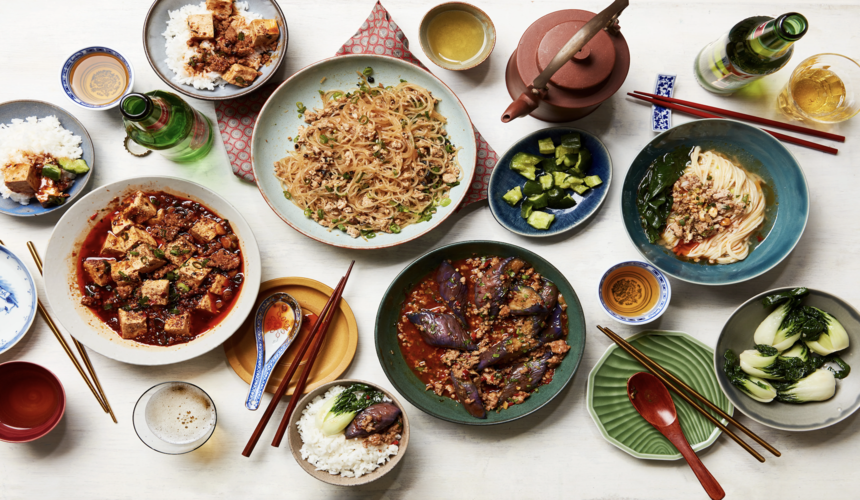
41 Chinese dishes you need to try
With one of the most diverse food scenes in the world, it is almost impossible to compile a single list of the best Chinese dishes. Even within the culmination of what is considered Chinese food as a whole, there are various regional Chinese cuisines, each influenced by different climates, terrains and people. The simple, salty and vegetable-free dishes such as clear broths come from the regions of northern China; light and seafood-heavy dishes such as dim sums come from the eastern provinces; and the west tends to eat halal food due to the Muslim and Tibetan influences in the region. The hot, spicy and fiery red foods synonymous with Sichuan cuisine are mostly eaten in central China. Such is the diversity of Chinese food. Here are some of the must-try dishes.
Steamed fish head with chopped salted chili
The cuisine of the mountainous, landlocked southern province of Hunan is often cooked with generous amounts of oil, salt and chilli. No dish is more representative of Hunan cuisine than steamed fish heads served with chopped salted chilli (duo jiao yu you). A staple of Hunanese households, duo jiao is made from dried and diced chilli peppers, which are then preserved in a jar of salt, ginger, garlic and baijiu (Chinese liquor) for at least a week. The thick coat of duo jiao gives the steamed fish head a salty and spicy kick. The leftover juice makes a delicious dip for noodles or dumplings after you’ve devoured the fish.

Rou jia mo
The ubiquitous Xi’an street food consists of a grilled flat bread and an overflowing amount of shredded pork belly, braised for hours in soy sauce, rock sugar and spices such as cinnamon, star anise, cloves and peppercorns.

Cross-the-bridge rice noodles
A loving wife invented cross-the-bridge rice noodles many years ago. Her husband studied on an island, so she would cross a bridge to deliver him his daily lunches. The chicken oil on the soup kept it warm. When he was ready to eat, she cooked the ingredients in the hot soup. Today, many noodle shops offer their own style of cross-the-bridge rice noodles, with different ingredients and soup bases.

Vermicelli with duck blood
Many Nanjing residents will tell you that they are the true duck capital of China. The city’s obsession with the bird is evident in its wide array of duck offerings. Nothing speaks to a duck lover’s heart quite like a cheap bowl of vermicelli soup with duck blood. This street food dish uses every part of the bird to deliver intense flavors.

Cantonese herbal soup
Cantonese parents know a thing or two about therapeutic herbal soups. These soups are simmered for hours to infuse the liquid with healing qualities and deliciousness. Various seasonal ingredients offer different cooling or warming qualities to restore balance in the body. For example, apple, snow fungus and lily petal soup will hydrate your body, whereas winter melon and barley soup will cool you down in hot weather.

Kungpao chicken
Kung Pao chicken is a famous Chinese dish made by stir-frying chicken with scallions, ginger, peppercorns, chili and deep-fried peanuts.

Biang biang noodles
Biang biang noodles are made by pulling long ropes of dough and smacking them against counters. The sound the noodle makes is “biang,” which is how the noodles got their name. The chewy wheat noodle is wide and long, and is often so long that a single noodle is enough for one serving. It’s often served with hot chili oil and bok choy.

Steamed fish
Steaming fish is difficult to make. Timing is crucial. The number of minutes you should steam a fish depends on the type and size of fish and your stove. If it’s undercooked, the flesh won’t come off the bone. If it’s overcooked, the flesh will be too tight and lose some moisture. Cantonese steamed fish is usually served with soy sauce and scallions.

Jian bing guozi
One of the most welcome sights on a cold morning in Tianjin is a jian bing stand, with its sizzling hot pan. Jian bing guozi is made of two things: crepes and deep-fried crisps. To make it, first, a mung bean mixture is spread onto a flat-iron pan. Eggs and scallions are then added to the crepe.

Roasted goose
Some restaurants use special types of wood, such as camphor or lychee wood, to give the bird a distinctive smoky flavour. When it hits your mouth, the goose magically falls apart, offering an explosion of combined flavours from the crispy skin, melted fat and tender meat.

Peking duck
One bite of this crispy duck skin, juicy meat, radish, cucumber, scallion and sweet bean sauce wrapped in a thin pancake, and you’ll understand why Peking duck has been a Chinese favourite for centuries. It is said that roasted duck first started being eaten more than 1,500 years ago in Nanjing. The capital moved to Beijing in the 1400s, and the imperial families brought the recipes with them. It was there that we started eating the duck wrapped in a thin pancake.

Sweet and sour pork
The pineapple and sauce add freshness to the crispy pork. The dish is called lychee pork. The pork pieces look like lychees after being deep-fried.

Pork belly with dry, pickled Chinese mustard
Pork belly is naturally irresistible, but the star of this Hakka dish is actually pickled Chinese mustard. It’s said that every Hakka family pickle their own mustard. When they make too much, they make a relish to put on plain rice and noodles.

Bao
Bao is a steamed bread roll filled with meat or vegetables. It could be plain or a big, round one. The best bao is sheng jian bao. It’s filled with pork and broth, and scallions and white sesame seeds are sprinkled on top.

Dongpo pork
Dongpo rou is made up of braised pork belly, rock sugar, soy sauce, yellow wine and other seasonings. The result is a tender, flavorful pork slab that can be easily cut with chopsticks. It’s a delicious dish that goes well with steamed white rice.

Sweet rice balls
Ningbo is one of the best places to sample these round mochi-like desserts. The soft, pillowy exterior is made with sticky rice while the filling is made of black sesame, sugar and lard.

Hot pot
Hot pot is an eating experience. It’s a big pot of hot broth with several smaller plates of dipping ingredients. You cook the ingredients in the broth. Dipping ingredients include sliced meats, meatballs, fish balls, noodles, rice cakes and veggies.

Douhua
A greatly preferred snack, douhua or tofu pudding can be found in various forms across the country. In its sweet form that is mostly preferred in the south, the silky soft tofu pudding is often served in a sweet sugar, water, and ginger syrup or simply served sprinkled with sugar. In northern China, douhua is served in a gravy of eggs, mushrooms, and bamboo shoots. In the heat-loving province of Sichuan, the pudding is dunked in chili oil and served alongside cold noodles in the summer or dan dan noodles in the winter.

Nian gao
The preparation of nian gao varies in each region of China. In the north, the cake is usually white or yellow, steamed or fried, and has a sweet taste. In the east, slices of nian gao are often stir-fried and served alongside scallions, meat, and cabbage. In the south, the Cantonese version of nian gao is stickier and darker in color due to the use of brown sugar. In some parts, the rice cake is stuffed with peanuts, dates, seeds, and nuts or with a red bean paste and jujube paste.

Tea eggs
Tea eggs have an intricate marbled appearance which forms after a sizable investment of time. First, an egg is hard-boiled and cracked, following which the egg is left to slowly cook in a liquid of soy sauce, tea leaves, and spices such as cinnamon, star anise, and Sichuan peppercorns. After several hours of cooking — days even — the liquid’s color and flavor infuses the egg making it very flavorful and leaving behind a marbled pattern on the egg once it is shelled.

Dan dan noodles
The name “Dan Dan Noodles” was derived from the manner in which they were initially sold over a century ago. They are currently sold on a “dan dan,” a carrying pole, by street hawkers. There are numerous ways to serve this renowned Sichuan specialty. Some believe that Dan Dan Noodles should contain a dry mix of noodles, made with minced meat, chopped scallions, spices, crushed peanuts, and various sauces. Most people would agree that dan dan noodles taste better when topped with a handful of rou saozi – finely chopped pork that’s been pan-fried in lard until golden brown and crispy.

Mapo tofu
Y You can enjoy salty, peppery and spicy flavors should all hit the taste buds in a single spoonful thanks to the different types of spices, peppers and chili used in the dish. Best Mapo Tofu is consider to made with Hanyuan peppercorns and broad bean chili paste from Sichuan’s Pidu district. It’s most commonly cooked with minced pork or beef – and tofu, of course.

Mooncake
If you’ve ever taken part in the Chinese Mid-Autumn Festival, you will have noticed tiny cake-like treats with beautiful decorations and inscriptions on top. These little cakes have a rich history, with a variety of legends surrounding them and a significant role in the autumn celebrations. The round cakes have a pastry skin with a paste of jujubes, lotus, or sweet red beans for filling. The filling can also include fruits, nuts, seeds, salted egg yolks, and occasionally, a savoury ingredient such as ham.

Wonton soup
Wonton soup is a simple broth filled with a few vegetable and meat-filled dumplings called wontons. It is usually boiled or deep-fried. Due to this, they are typically made with a dough that is quite thin. This thin wrapper allows the heat from boiling water or hot oil to penetrate into the interior of the dumpling, cooking any meat inside.

Preserved sausages
Laap cheung is a preserved meat sausage that has a slightly sweet taste. Yun cheung, on the other hand, is mostly made with offal from poultry, giving it a stronger and gamier flavour. In contrast to their European counterparts, Chinese preserved sausages are typically steamed before consumption. They are commonly found wrapped in buns, stir-fried with sticky rice, or steamed in clay pots.

Chaozhou beef balls
A family-sized bag of super bouncy and flavoursome meatballs made of beef beaten by hand is a popular item for visitors to Chaozhou to purchase. These meatballs are highly praised for their understanding of beef.

Dumplings
They are suitable for steaming, boiling or pan-frying. Jiaozi, which are dumplings, pack a full punch of carbs, proteins and vegetables in one mouthful. Vinegar and chili oil are some of the best condiments to go with Chinese dumplings. One of the most distinctive styles of dumplings is Fujian’s rouyan version. The mini pork dumplings have an extra chewiness to them as their wrappers are made of pork and some flour.

Chaozhou cold fish/crab
Seaside Chaozhou is renowned for its uncomplicated seafood dishes, which are designed to showcase the fresh ingredients’ original umami flavors. Among the most exemplary dishes showcasing this style is Chaozhou-style cold fish or cold crab. To preserve the freshness of the seafood, fish and crabs are lightly seasoned in salt before steaming. They are then cooled and served at room temperature. The fish is often dipped in a special soy bean paste from Poling, while the crabs are served with a garlic and vinegar sauce.

Stinky tofu
In China, stinky tofu is a popular street food that is deep-fried, grilled, steamed, and stewed. It is typically served with pickled cabbage and garlic chili sauce. It has also been served with hoisin sauce. Although this dish is available on the mainland, it is particularly popular in Taiwan.

Scallion pancake
To prepare Chinese scallion pancakes, a dough of flour, water, and salt is rolled into a long, thin rectangular shape. The dough is then brushed with and thin coat of oil and seasoned before chopped scallions are sprinkled over top. The elongated dough is then rolled into a tube shape, which is then coiled into a disc. This disc is then lightly rolled before the entire flatbread is pan-fried. The result is a finger-thick pancake with little layers of seasoned dough that is studded with scallions.

Barbecue pork
The optimal barbecue pork should exhibit slight charring on the exterior and an ideal balance of sweetness and saltiness derived from maltose, wine, and soy sauce. A Cantonese roast shop offers the flexibility to customize the degree of fattiness in char siu. For those new to the cuisine, a half-lean, half-fatty char siu is a recommended option. Barbecue pork is a highly versatile ingredient, suitable for use in a wide range of dishes. It can be enjoyed in breakfast dishes such as char siu macaroni soup, as well as in dim sum, where it is served in steamed buns.

Hot and sour soup
It is worth noting that China’s famed hot and sour soup is not only a winter warmer, but also has the ability to expel excess humidity and heat from the body in summer. A bowl of hot and sour soup should have a balance of sourness from vinegar and spiciness from peppers. Some common ingredients found in the thick soup are shreds of tofu, Chinese mushrooms, wood ears and bamboo shoots.

Wenchang chicken rice
Wenchang chicken is a special breed of poultry from the island’s eponymous Hainan city. It is prized for its thin skin, tender meat and sweet flavour. The most common method of cooking a Wenchang chicken is by blanching and air drying it. Hainan locals typically prefer garlic and ginger paste, chili sauce and the juice of small tangerines as condiments.

Zongzi
Depending on the region, zongzi can be filled with sweet ingredients such as red bean or date pastes or in savoury forms with meat in between. Regardless of the filling, zongzi traditionally comes wrapped in bamboo leaves, but can also be steamed in other leaves, such as reed or banana.

Shizi tou
Shizi tou is made from minced pork dumplings that are slowly braised using the red cooking method until they are tender and flavourful. It is usually served hot with Chinese cabbage, which is usually cooked in the same pot using the red cooking method. Occasionally you can find white versions of shizi tou, where the meatballs are simmered in a simple broth instead.

Xiaolongbao
Xiaolongbao, also known as xiaolong tangbao, which has a huge following in and outside China, is a mixture of soup and pork wrapped in a thin dumpling casing. As well as pork, the soupy dumplings can also be filled with crab meat and crab roe.

Dim sum
It’s a type of meal in Cantonese food culture rather than a specific dish. It’s a clever way to incorporate many different kinds of small plates. From pan-fried radish cakes to prawn dumplings to siu mai. At the same time, eating a combination of these dishes during a dim sum session is much more enjoyable than eating just one.

Youtiao
Youtiao, a popular breakfast dish in China, are strips of dough deep-fried until golden and crispy on the outside, with pockets of soft dough and air on the inside. They can be eaten with a bowl of congee, but are traditionally eaten dipped in sweetened soy milk.

Congee
When it comes to nourishing the digestive system, in sickness and in health, it’s all about congee. A popular breakfast staple in many parts of China, this versatile and inexpensive food can be served plain with a drizzle of soy sauce and spring onions, or stewed with savoury ingredients such as chicken or fish. Lean pork and century egg congee is a classic served in southern China.

Cheong fun
Cheong fun is a simple Chinese noodle made from rice flour, but the noodle is so silky, translucent and tender. The light rice noodles can be eaten on their own or dipped in a sauce made from a combination of sesame oil, oyster sauce, light and dark soy sauce and rock sugar. Cheong fun can also be wrapped around various meats such as char siu pork or seafood.

Tanghulu
Similar to a candied apple, tanghulu is a dessert, sweet and snack all in one. A Chinese snack that is readily available almost everywhere in China, tanghulu is made from sugar-coated fruits skewered in rows on a bamboo stick.

Now that you have a better idea of all the foods you can try in China, make sure you try some of them while you are in China!



